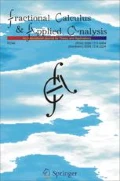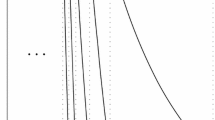Abstract
The classical “ε-δ” definition of limits is of little use to quantitative purposes, as is needed, for instance, for computational and applied mathematics. Things change whenever a realistic and computable estimate of the function δ(ε) is available. This may be the case for Lipschitz continuous and Hölder continuous functions, or more generally for functions admitting of a modulus of continuity. This, provided that estimates for first derivatives, fractional derivatives, or the modulus of continuity might be obtained. Some examples are given.
Similar content being viewed by others
References
D. Bambusi, N.N. Nekhoroshev, Long time stability in perturbations of completely resonant PDE’s. Symmetry and perturbation theory. Acta Appl. Math. 70, Nos 1-3, (2002), 1–22.
K. Diethelm, The Analysis of Fractional Differential Equations.. Springer, Berlin (2010).
K. Diethelm, The mean value theorems and a Nagumo-type uniqueness theorem for Caputo’s fractional calculus. Fract. Calc. Appl. Anal. 15, No 2 (2012), 304–313; DOI: 10.2478/s13540-012-0022-3; https://www.degruyter.com/view/journals/fca/15/2/fca.15.issue-2.xml/view/journals/fca/15/2/fca.15.issue-2.xml; Erratum: The mean value theorems and a Nagumo-type uniqueness theorem for Caputo’s fractional calculus, Fract. Calc. Appl. Anal. 20, No 6 (2017), 1567–1570; DOI: 10.1515/fca-2017-0082; https://www.degruyter.com/view/journals/fca/20/6/fca.20.issue-6.xml/view/journals/fca/20/6/fca.20.issue-6.xml.
A.V. Efimov, Modulus of continuity. Encyclopaedia of Mathematics, Springer, 2001, (ISBN 1-4020-0609-8); http://eom.springer.de/c/c025580.htm.
I. Ekeland, R. Temam, Convex Analysis and Variational Problems.. North-Holland American Elsevier, Amsterdam and New York (1976).
S.G. Gal, Calculus of the modulus of continuity for nonconcave functions and applications. Calcolo 27, Nos 3-4, (1990), 195–202.
J.A. Gallegos, M.A. Duarte-Mermoud, Boundedness and convergence on fractional systems. J. Comput. Appl. Math. 296 (2016), 815–826.
R. Garrappa, E. Kaslik, M. Popolizio, Evaluation of fractional integrals and derivatives of elementary functions: Overview and tutorial. Mathematics, Open Access (MDPI) 7 (2019), # 407, 21pp.; doi: 10.3390/math7050407; https://www.mdpi.com/journal/mathematics/journal/mathematics.
M. Guzzo, E. Lega, The Nekhoroshev theorem and the observation of long-term diffusion in hamiltonian systems. Regul. Chaotic Dyn. 21, No 6 (2016), 707–719.
G.H. Hardy, J.E. Littlewood, Some properties of fractional integrals, I. In: Collected Papers of G.H. Hardy, Vol. 1, Ed. by the London Math. Soc., Clarendon Press, Oxford, 1966, 565–606.
A. Iouditski, Lecture 3. Convex Functions.; https://ljk.imag.fr/membres/Anatoli.Iouditski/optimisation-convexe.htm/membres/Anatoli.Iouditski/optimisation-convexe.htm.
M. Kac, G.-C. Rota, J.T. Schwartz, Discrete Thoughts. Essays on Mathematics, Science and Philosophy.. Birkhäuser, Boston, 1992; 2nd Ed. 2008.
N.N. Nekhoroshev, The behavior of Hamiltonian systems that are close to integrable ones (In Russian). Funkcional Anal. i Priložen. 5, No 4 (1971), 82–83; MR0294813; Engl. version: Behavior of Hamiltonian systems close to integrable. Functional Analysis and Its Applications 5, No 4 (1971), 338–339.
Z.M. Odibat, N.T. Shawagfeh, Generalized Taylor’s formula. Appl. Math. Comput. 186 (2007), 286–293.
F.W.J. Olver, Asymptotics and Special Functions. Reprint of the 1974 original [Academic Press, New York]. AKP Classics. A.K. Peters, Wellesley, (1997).
B. Ross, S.G. Samko, E.R. Love, Functions that have no first order derivative might have fractional derivatives of all orders less than one. Real Anal. Exchange 20, No 1 (1994/5), 140–157.
D.R. Smith, Singular-Perturbation Theory.. Cambridge University Press, Cambridge (1985).
R. Spigler, M. Vianello, Improved estimates for the derivatives of the O-symbols in view of numerical applications. J. Math. Anal. Appl. 164, No 2 (1992), 480–488.
S.M. Ulam, Adventures of a Mathematician.. Charles Scribner’s Sons, New York (1976).
Author information
Authors and Affiliations
Corresponding author
About this article
Cite this article
Spigler, R. On a Quantitative Theory of Limits: Estimating the Speed of Convergence. Fract Calc Appl Anal 23, 1013–1024 (2020). https://doi.org/10.1515/fca-2020-0053
Received:
Published:
Issue Date:
DOI: https://doi.org/10.1515/fca-2020-0053



